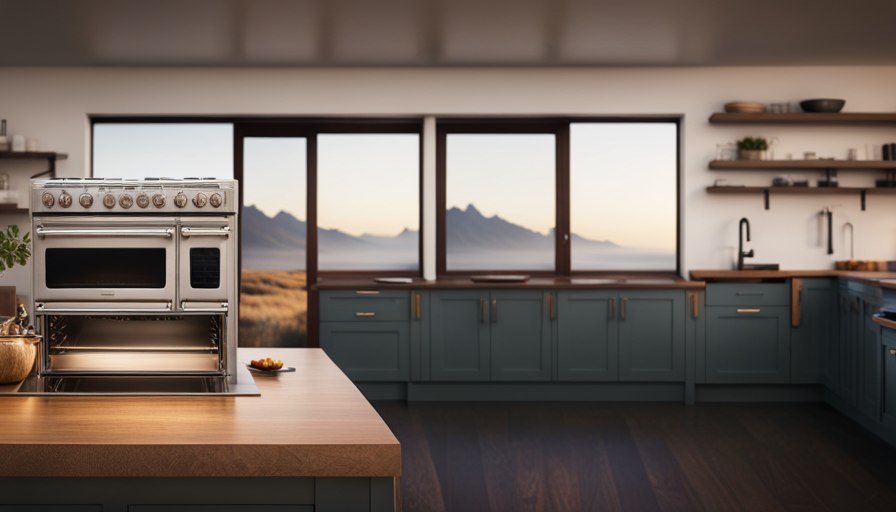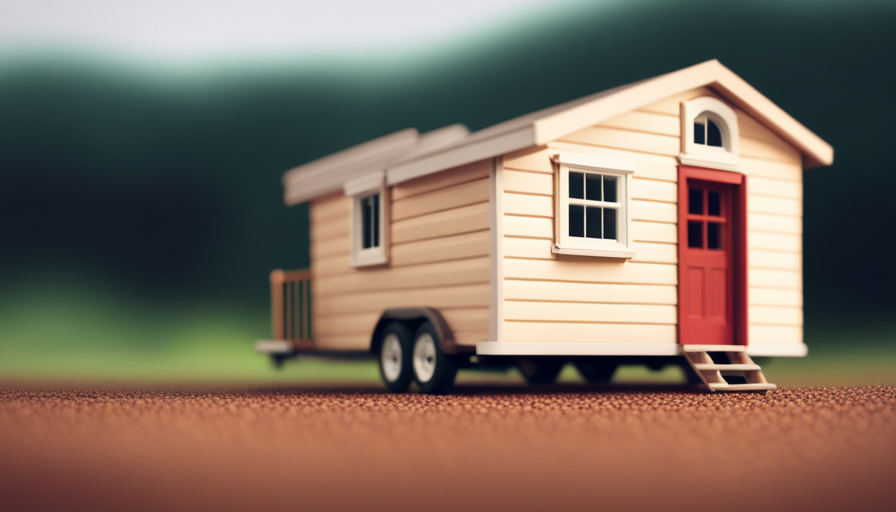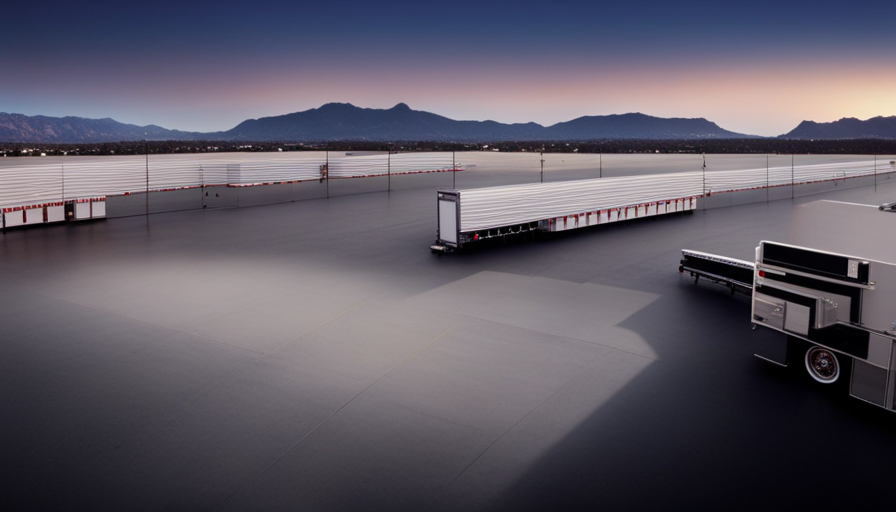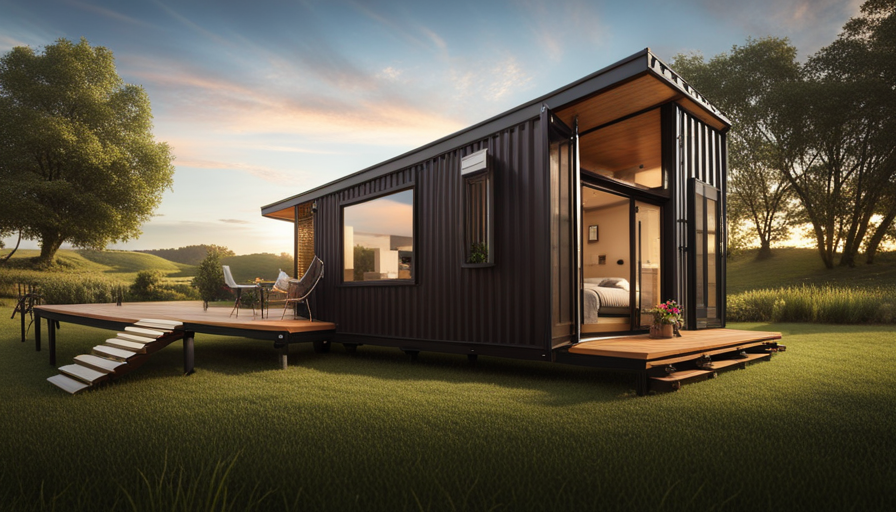Imagine stepping into a charming cabin tucked away in the woods, surrounded by the tranquility of nature. As you walk in, you can’t help but notice a small kitchen with a unique oven and stove that immediately catches your eye. This is no ordinary kitchen – it’s a part of a tiny home. In the world of compact living, every single inch matters, including the appliances that are chosen.
A tiny house oven and range differ from conventional ones in several ways, offering a blend of functionality and practicality that is perfectly suited for compact living spaces. From their size and energy efficiency to their cooking capacity and mobility, these specialized appliances are designed to optimize space and enhance the overall tiny house experience.
In this article, we will explore the key differences between a tiny house oven and range and their conventional counterparts, shedding light on the unique features and benefits that make them an essential component of tiny living.
Key Takeaways
- Tiny house ovens and ranges are designed for compact living spaces and maximize size and space efficiency.
- They are energy efficient and can save money on energy bills and reduce environmental impact.
- Despite their small size, they offer impressive cooking performance and temperature control.
- Tiny house ovens and ranges offer various power source options and can be used in areas with readily available power or in off-grid situations.
Size and Space Efficiency
The tiny house oven and range are specifically designed to maximize size and space efficiency, making them perfect for small living spaces. These compact appliances are created with a focus on multi-functionality, allowing them to serve multiple purposes within a limited space.
The oven and range are designed to be compact in size, taking up minimal space in the kitchen area of a tiny house. Despite their smaller size, these appliances still provide all the necessary functionalities of a conventional oven and range.
The compact design of the tiny house oven and range allows for a more efficient use of space in the kitchen area. These appliances are often built with smart storage solutions, such as built-in drawers or compartments, to maximize the storage potential in a tiny house. Additionally, the oven and range may also be designed to serve multiple functions, such as incorporating a microwave or convection oven feature, further saving space by eliminating the need for separate appliances.
Transitioning into the next section about energy efficiency, it’s important to note that the size and space efficiency of the tiny house oven and range also contribute to their energy-saving capabilities.
Energy Efficiency
Imagine how much money you could save on your energy bills by using a tiny house oven and range instead of a regular oven and range. The energy efficiency of a tiny house oven and range is remarkable. Here are three reasons why:
-
Insulation: Tiny house ovens and ranges are designed with superior insulation, which helps to retain heat and reduce energy consumption. This means that less energy is wasted and more is used for cooking, resulting in significant energy savings.
-
Size and Capacity: Tiny house ovens and ranges are smaller in size compared to conventional ones. This smaller size means they require less energy to heat up, resulting in reduced energy usage. Additionally, the smaller cooking capacity promotes efficient cooking practices, as it encourages users to cook only what is necessary, reducing waste and further contributing to energy savings.
-
Energy Source: Many tiny house ovens and ranges are designed to be powered by alternative energy sources such as propane or solar power. This not only reduces reliance on traditional energy sources but also has a positive environmental impact by reducing carbon emissions.
By using a tiny house oven and range, not only can you save money on your energy bills, but you can also reduce your environmental impact. Now, let’s explore the cooking capacity of these compact appliances.
Cooking Capacity
Get ready to discover the surprising cooking capabilities of these compact appliances that’ll revolutionize your culinary experience.
Despite their small size, tiny house ovens and ranges offer impressive cooking performance and temperature control. These appliances are designed to provide efficient and effective cooking results while utilizing minimal space.
When it comes to cooking performance, tiny house ovens and ranges excel in their ability to evenly distribute heat. The compact size allows for better heat circulation, ensuring that your food is cooked evenly and thoroughly. Whether you’re baking, roasting, or broiling, these appliances deliver consistent and reliable results.
Temperature control is also a key feature of tiny house ovens and ranges. These appliances offer precise temperature settings, allowing you to cook your food at the desired heat level. Whether you need a high temperature for searing or a low temperature for simmering, these appliances can accommodate your cooking needs.
In addition to their impressive cooking capabilities, tiny house ovens and ranges also offer various power source options. From propane to electric, you can choose the power source that best suits your needs and preferences. This flexibility ensures that you can enjoy the benefits of a fully functional oven and range, regardless of your power source availability.
With their remarkable cooking performance and temperature control, tiny house ovens and ranges are a game-changer for anyone looking to maximize their culinary experience.
Now, let’s explore the different power source options available for these compact appliances.
Power Source Options
Explore the power source options available for these compact culinary appliances and unleash a world of culinary possibilities. When it comes to tiny house ovens and ranges, they offer a variety of power source options that cater to different needs and preferences. Here are three sub-lists that delve into the details:
-
Electricity: Most tiny house ovens and ranges are designed to run on standard electricity, just like their conventional counterparts. This makes them convenient to use in areas where power is readily available, such as RV parks or tiny house communities. They simply require a connection to an electrical outlet to operate.
-
Propane: For those seeking alternative fuel sources or off-grid capabilities, propane-powered ovens and ranges are a popular choice. Propane provides a reliable and efficient source of energy, allowing you to cook even when electricity is not accessible. It is commonly used in tiny houses that prioritize self-sufficiency or are located in remote areas.
-
Wood-burning: For a rustic and eco-friendly option, some tiny house ovens and ranges can be fueled by wood. This alternative power source adds a unique charm to the cooking experience and is particularly appealing for those who enjoy traditional cooking methods or want to minimize their carbon footprint.
By considering these power source options, you can select the one that best suits your needs and culinary preferences, ensuring that your tiny house oven and range provide the functionality and convenience you desire.
Now, let’s move on to the next section about mobility and portability.
Mobility and Portability
Picture yourself with a compact culinary appliance that offers incredible mobility and portability, allowing you to cook your favorite meals wherever adventure takes you. When it comes to tiny house ovens and ranges, their mobility and portability are key features that set them apart from conventional appliances.
These compact appliances are designed to be lightweight and easy to move around, making them perfect for tiny houses or even outdoor cooking. The versatility of a tiny house oven and range is truly remarkable. Despite their small size, these appliances offer a wide range of cooking options, from baking and broiling to grilling and frying. They are equipped with multiple burners, allowing you to cook different dishes simultaneously. Some models even come with additional features like convection cooking or built-in timers, enhancing their functionality and convenience.
In terms of design and aesthetics, tiny house ovens and ranges come in various styles and finishes to match your personal taste. Whether you prefer a sleek stainless steel look or a more traditional design, there’s a tiny house oven and range that will complement your kitchen perfectly.
Transitioning into the next section about ‘design and aesthetics,’ it’s important to consider not only the functionality of a tiny house oven and range, but also how it’ll contribute to the overall aesthetic appeal of your tiny home.
Design and Aesthetics
Imagine the breathtaking beauty and exquisite elegance that a perfectly designed and aesthetically pleasing culinary centerpiece can bring to your tiny home, effortlessly merging style and functionality into one harmonious masterpiece.
When it comes to the design and aesthetics of a tiny house oven and range, there are several key factors to consider. First and foremost, material selection plays a crucial role in the overall look and feel of the oven and range. High-quality stainless steel or sleek black finishes are popular choices, as they don’t only add a touch of sophistication but also ensure durability and longevity. These materials are easy to clean and maintain, making them ideal for the compact environment of a tiny house.
Integration with the overall interior design is another important aspect to consider. The oven and range should seamlessly blend in with the surrounding cabinetry and countertops, creating a cohesive and visually appealing space. This can be achieved through thoughtful design choices, such as matching hardware, complementary colors, and streamlined shapes.
The design and aesthetics of a tiny house oven and range are carefully crafted to enhance the overall ambiance and visual appeal of the space. Material selection and integration with the overall interior design are key considerations in achieving a cohesive and stylish look.
Moving forward, let’s explore the safety features that are essential for a tiny house oven and range.
Safety Features
Ensuring the utmost safety and peace of mind, the compact culinary centerpiece of a tiny home is equipped with essential features that protect against potential hazards.
The safety features of a tiny house oven and range are specifically designed to address the unique challenges and limitations of a small living space.
One important safety feature is efficient heating. Tiny house ovens and ranges are designed to heat up quickly and evenly, ensuring efficient cooking and reducing the risk of overheating. This is achieved through the use of advanced heating elements and insulation materials that maximize energy efficiency while minimizing the risk of fire or burns.
Another crucial safety feature is temperature control. Tiny house ovens and ranges are equipped with precise temperature controls that allow users to maintain the desired cooking temperature with accuracy. This helps prevent food from burning or undercooking, reducing the risk of foodborne illnesses.
In addition, tiny house ovens and ranges often come with built-in safety mechanisms such as automatic shut-off features. These features detect abnormal temperature fluctuations or other potential dangers and automatically turn off the oven or range to prevent accidents.
Transitioning to the subsequent section about ‘cost and affordability’, it’s important to note that these safety features don’t compromise the overall affordability of a tiny house oven and range.
Cost and Affordability
When it comes to the cost and affordability of a tiny house oven and range, there are a few key factors to consider. Firstly, the installation process of these appliances in a tiny house is typically simpler and more cost-effective compared to a conventional oven and range. Due to the smaller size of a tiny house, the installation requires less time, materials, and labor.
In terms of cost, tiny house ovens and ranges can vary in price depending on the brand, features, and quality. Generally, they tend to be more affordable than their conventional counterparts. This affordability is often attributed to the smaller size and simpler design of these appliances.
However, it’s important to note that the durability and lifespan of a tiny house oven and range may differ from a conventional oven and range. While both types of appliances are designed to be durable and long-lasting, the smaller size and potentially lighter construction of tiny house appliances could result in a slightly shorter lifespan.
The installation process of a tiny house oven and range is typically easier and more affordable compared to a conventional oven and range. While these appliances are generally durable, their lifespan may be slightly shorter.
Moving on to the next section about maintenance and cleaning, it’s important to understand the steps involved in keeping these appliances in top condition.
Maintenance and Cleaning
To properly maintain and clean your compact cooking appliances, it’s essential to follow a regular maintenance routine and use appropriate cleaning methods. Here are some maintenance tips and cleaning hacks to help you keep your tiny house oven and range in top shape:
-
Regularly clean the burners and oven racks to prevent the buildup of grease and food residue.
-
Use a non-abrasive cleaner and a soft cloth to wipe down the exterior surfaces of the oven and range.
-
Clean the oven door glass with a mixture of baking soda and water to remove stubborn stains.
-
Check and replace the oven gasket if it becomes worn or damaged to ensure a proper seal and prevent heat loss.
-
Clean the exhaust fan and filter regularly to improve ventilation and prevent odors.
By following these maintenance tips and cleaning hacks, you can ensure that your tiny house oven and range continue to function efficiently.
In the next section, we’ll explore the various personalization and customization options available for your compact cooking appliances.
Personalization and Customization Options
With a sprinkle of creativity, you can transform your compact cooking appliances into unique culinary masterpieces. Tiny house ovens and ranges offer a variety of customization options and personalization choices that allow you to tailor your cooking experience to your specific needs and preferences.
One of the main advantages of tiny house ovens and ranges is their flexibility in terms of design and appearance. You can choose from a range of colors, finishes, and styles to match your overall interior decor. Whether you prefer a sleek and modern stainless steel look or a more rustic and vintage aesthetic, there are options available to suit your taste.
In addition to the visual customization, you can also personalize the functionality of your tiny house oven and range. Many models offer adjustable temperature settings, allowing you to fine-tune the heat for precise cooking results. Some ovens even come with specialized cooking modes, such as convection or steam cooking, to expand your culinary repertoire.
Furthermore, you can customize the layout and configuration of your tiny house oven and range to optimize your cooking space. Some models offer modular components that can be rearranged to fit your specific needs. For example, you can choose to have a separate oven and cooktop, or opt for a combined unit to save space.
Overall, the customization options and personalization choices available for tiny house ovens and ranges provide you with the opportunity to create a cooking environment that is uniquely yours. By selecting the right colors, finishes, and configurations, you can turn your compact cooking appliances into functional and stylish additions to your tiny home.
Frequently Asked Questions
Can a tiny house oven and range be used for baking?
Yes, a tiny house oven and range can be used for baking. Baking in a small space requires maximizing oven efficiency. The compact design of a tiny house oven allows for efficient heat distribution, ensuring even baking. It’s important to preheat the oven properly and use the correct temperature for your recipe. Additionally, using baking tools and accessories specifically designed for small spaces can help optimize the baking process in a tiny house oven.
Are there any special requirements for installing a tiny house oven and range?
When installing a tiny house oven and range, there are special considerations to keep in mind. Firstly, the size and weight of the unit should be compatible with the limited space in a tiny house.
Additionally, proper ventilation is crucial to prevent heat buildup and ensure safety. It’s important to follow the manufacturer’s instructions for installation, which may involve connecting to a propane or electric power source. Professional assistance may be necessary to ensure a smooth and safe installation process.
What are the common safety features found in tiny house ovens and ranges?
Tiny house oven and range safety features include automatic shut-off systems, heat-resistant materials, and ventilation systems. These safety features ensure that the oven and range are safe to use in the limited space of a tiny house.
Additionally, tiny house ovens and ranges offer advantages such as energy efficiency, compact size, and versatility. They’re designed to fit in small spaces without compromising on functionality, making them ideal for tiny house living.
Are there any limitations to the cooking capacity of a tiny house oven and range?
There are indeed limitations to the cooking capacity of a tiny house oven and range. Due to their smaller size, these appliances typically have less cooking space and may not be able to accommodate large dishes or multiple items at once. Additionally, the heat output and temperature control may be limited, affecting the cooking performance. It’s important to consider these limitations when planning meals and cooking in a tiny house kitchen.
Can a tiny house oven and range be used with propane gas?
Yes, a tiny house oven and range can be used with propane gas. It’s like having a trusty sidekick that saves energy while delivering powerful cooking performance. Propane gas compatibility allows for precise temperature control, ensuring your culinary creations are cooked to perfection.
Not only does it provide convenience and portability, but it also offers exceptional energy efficiency, making it a smart choice for tiny house living. Say goodbye to limitations and hello to delicious meals in your cozy kitchen.
Conclusion
In conclusion, the tiny house oven and range offer a delightful departure from the conventional options. They make the most of every inch in your tiny haven with their compact size and space efficiency. Not only are they energy efficient, but they also boast impressive cooking capacity.
The range of power source options gives you the freedom to choose what suits your needs best. Plus, their mobility and portability add a touch of adventure to your culinary endeavors. With safety features, cost-effectiveness, and easy maintenance, these ovens and ranges are the perfect fit for tiny house living.
And let’s not forget the personalization and customization options that allow you to truly make it your own. So, why settle for a standard oven and range when you can have a charming and functional tiny house version?
Hi, I’m Emma. I’m the Editor in Chief of Tiny House 43, a blog all about tiny houses. While tree houses are often associated with childhood, they can be the perfect adult retreat. They offer a cozy space to relax and unwind, surrounded by nature. And since they’re typically built on stilts or raised platforms, they offer stunning views that traditional homes simply can’t match. If you’re looking for a unique and romantic getaway, a tree house tiny house might just be the perfect option.










